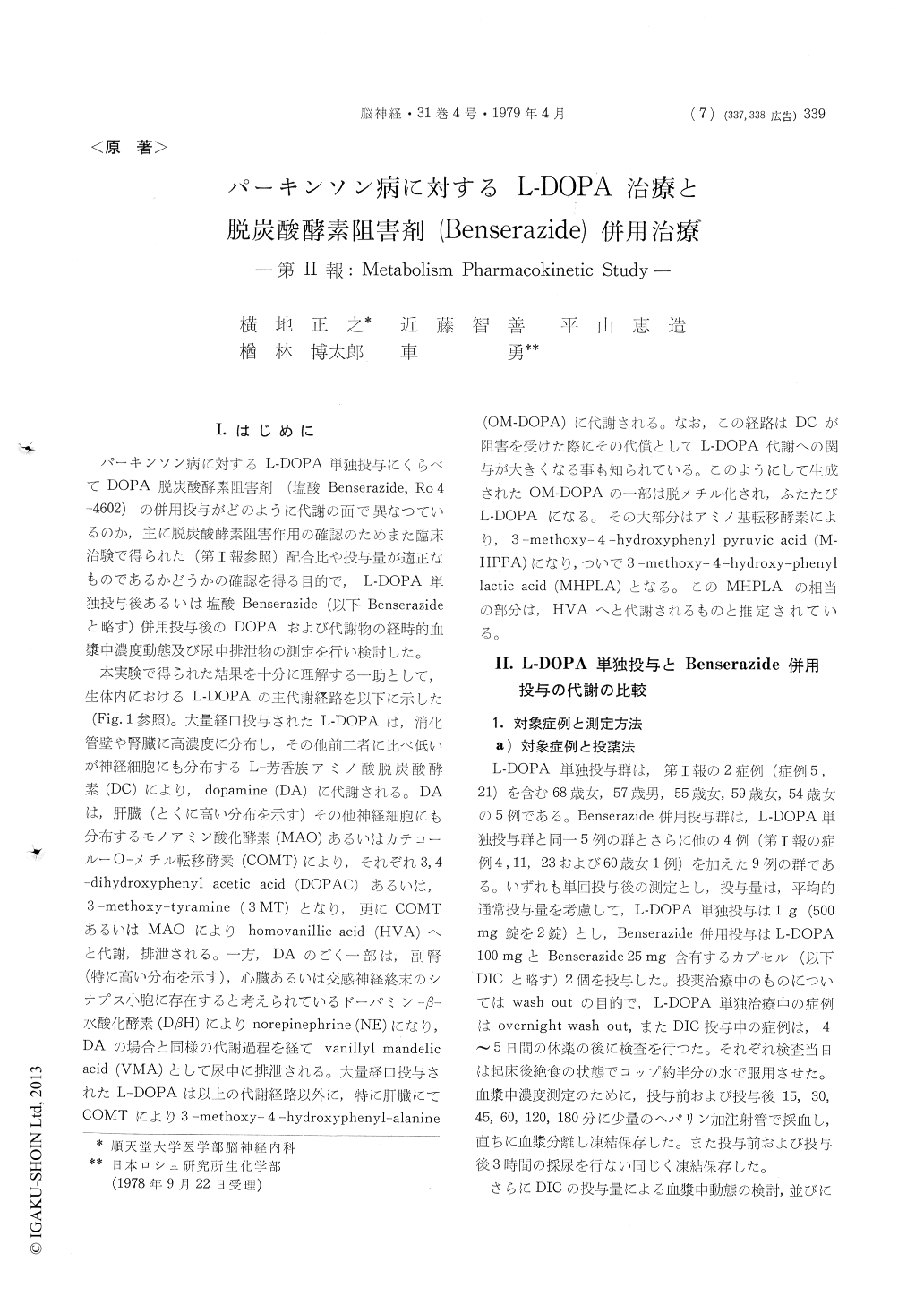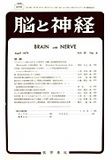Japanese
English
- 有料閲覧
- Abstract 文献概要
- 1ページ目 Look Inside
I.はじめに
パーキンソン病に対するL-DOPA単独投与にくらべてDOPA脱炭酸酵素阻害剤(塩酸Benserazide,Ro 4−4602)の併用投与がどのように代謝の面で異なつているのか,主に脱炭酸酵索阻害作用の確認のためまた臨床治験で得られた(第I報参照)配合比や投与量が適正なものであるかどうかの確認を得る目的で,L-DOPA単独投与後あるいは塩酸Benserazide (以下Benserazideと略す)併用投与後のDOPAおよび代謝物の経時的血漿中濃度動態及び尿中排泄物の測定を行い検討した。
本実験で得られた結果を十分に理解する一助として,生体内におけるL-DOPAの主代謝経路を以下に示した(Fig.1参照)。大量経口投与されたL-DOPAは,消化管壁や腎臓に高濃度に分布し,その他前二者に比べ低いが神経細胞にも分布するL—芳香族アミノ酸脱炭酸酵素(DC)により,dopamine (DA)に代謝される。DAは,肝臓(とくに高い分布を示す)その他神経細胞にも分布するモノアミン酸化酵素(MAO)あるいはカテコールーO—メチル転移酵素(COMT)により,それぞれ3,4—dihydroxyphenyl acetic acid (DOPAC)あるいは,3—methoxy-tyramine (3MT)となり,更にCOMTあるいはMAOによりhomovanillic acid (HVA)へと代謝,排泄される。
This study was planned to obtain the substantial data for the benserazide/L-DOPA combination therapy for Parkinson's disease. Administration of L-DOPA alone and in combination with benserazide was done to the same groupe of 5 patients and the influence of benserazide on the metabolism of L-DOPA was studied by measuring the plasma levelof DOPA, 3-0-methyldopa, dopamine (DA), 3, 4- dihydroxyphenyl acetic acid (DOPAC), 3-methoxy-tyramine (3-MT) and homovanillic acid (HVA) and the urinary excretion of DOPA, DA, DOPAC, 3-MT and norepinephrine (NE) after the adminis-tration. The results are summarized as follows :
1) Five patients with paralysis agitans were given L-DOPA tablet (1000 mg) and the same patients were received 200 mg of L-DOPA in combination with 50 mg of benserazide HCI. The areas under the blood concentration curves (AUC) of DOPA and 3-0-methyldopa following the combined drug averaged 1.52 μg/ml・hr and 3.65 μg/ml・hr, respectively and were approximately 1.5 and 2.0 times higher than those following L-DOPA alone. On the other hand, after the administration of the combined drug the plasma levels of de-carboxylated metabolites of DOPA such as DA, 3-MT, DOPAC and HVA were not elevated over their level observed before the administration, while after L-DOPA alone the peak plasma levels of these metabolites were maintained more than 3 hours. The metabolic profile of DOPA in the urine tended to support the above results. Namely, after the administration of the combined drug the urinary excretion of DOPA shared about 20 percent of total metabolites, whereas it shared only 0.7 percent after L-DOPA alone.
2) AUC for DOPA after a single oral adminis-tration of 300 mg of L-DOPA in combination with 75 mg of benserazide was shown to be 4.69 μg/ ml・hr and was much higher than that expectedfrom the result obtained after the administration of 200 mg of L-DOPA in combination with 50 mg of benserazide.
3) The plasma level of DOPA was investigated in 4 Parkinsonian patients after oral administrations of L-DOPA in combination with benserazide in various ratios, e. g. 3 : 2, 4 : 1 and 10 : 1 (L-DOPA 200 mg : benserazide). The plasma level profile of DOPA following a single oral administration of the combined drug in 3 : 2 ratio showed a sharp rise and a rapid decline. Such a profile might cause, during repeated administrations, undesirable side effects such as abnormal involuntary move-ments and unpredictable oscillations of symptoms. However following the combined drug in 4 : 1 or 10 : 1 ratio the blood profiles of DOPA were es-sentially similar to that observed following L-DOPA alone. After the administration of the combined drug in 3 : 2 ratio the largest AUC for DOPA was observed but no significant difference in AUC was observed between 10: 1 and 4: 1 combinations.
4) Following the consecutive administration (for 1 month) of the combined drug in 4 : 1 ratio to 3 patients, mean AUC for DOPA was 1.7 times larger than that following the consecutive admin-istration of combined drug in 10 : 1 ratio to the same patients.
In conclusion, the results may suggest that the 4 : 1 combination is better than the 10 : 1 combi-nation.

Copyright © 1979, Igaku-Shoin Ltd. All rights reserved.


